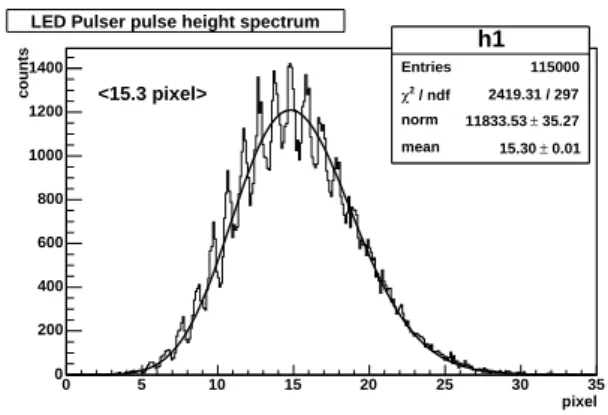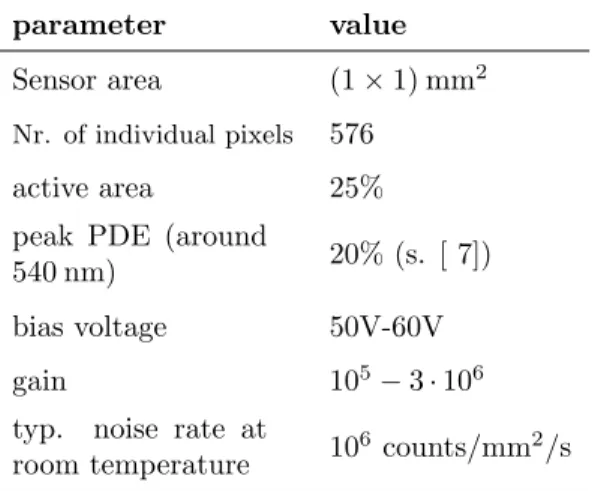The Potential of SiPM as Photon Detector in Astroparticle Physics Experiments like MAGIC and EUSO
N. Otte
a∗B. Dolgoshein
bJ. Hose
aS. Klemin
cE. Lorenz
aR. Mirzoyan
aE. Popova
bM. Teshima
aa
Max-Planck-Institut for Physics,
F¨ohringer Ring 6, 80805 Munich, Germany
b
Moscow Engineering and Physics Institute, Kashirskoe Shosse 31, 115409 Moscow, Russia
c
”Pulsar” Enterprise,
Okruzhnoj Proezd 27, Moscow, Russia
We discuss the prospects to use a novel photon detector — the so-called SiPM — for the high energy astroparticle physics experiments EUSO and MAGIC. We explain the principle of these photon sensors and present results obtained with some prototypes. Peak photon detection efficiency (PDE) of the devices available is currently about 20%. Already in its existing form Geiger mode APDs offer a very promising replacement candidate for conventional photomultiplier tubes (PMTs) in both experiments, provided some improvements can be achieved.
1. Introduction
The MAGIC air Cherenkov telescope for ground-based γ–astronomy[ 1] is located on the Canarian island of La Palma. The currently comissioned telescope is designed to detect very high energy gammas (VHE-γ) with energies from a few tens of GeV up to several TeV. When a VHE-γ enters the earth atmosphere it initiates an electromagnetic shower. In the air shower Cherenkov technique a snapshot of the shower is taken by detecting the Cherenkov light emit- ted by relativistic shower particles. By analyzing these images the energy of the gamma as well as its incoming direction can be reconstructed and correlated with cosmic sources.
The number of Cherenkov photons arriving on ground is typically 100 photons per square meter for a 1 TeV gamma and scales in first order lin- early with the γ energy. Experiments with large collection areas as well as highly efficient and fast photon detectors are needed to record these low light fluxes in the presence of a huge light back- ground from the night sky.
The MAGIC collaboration plans to study the
∗
corresponding author; email: otte@mppmu.mpg.de
physics of some of the most energetic galactic and extragalactic objects known so far. Among these are active galactic nuclei (AGN’s), super- nova remnants (SNR’s) and gamma ray bursts (GRB’s). For a detailed description of the physics program we refer, e. g. to the MAGIC design re- port [ 2].
EUSO is a proposed spaceborne experiment to detect ultra high energy cosmic rays interacting with the earth atmosphere[ 3] [ 4]. It is planned to attach EUSO to the International Space Sta- tion in 2012. By looking down on the earth at- mosphere EUSO shall be able to detect the fluo- rescence light emitted by cosmic ray induced ex- tended air showers (EAS).
The detection of fluorescence light from space makes EUSO–like detectors a unique tool to study the nature and origin of cosmic rays at extreme energies (> 10
19eV) because of the ex- tremely large collection area.
EUSO will be able to study the GZK-cutoff at
around 10
20eV with a statistical precision not ac-
cessible to ground-based experiments due to the
large differences in the observed atmospheric vol-
ume. Above energies of 10
19eV the deflection of
charged particles by the galactic magnetic field
becomes small. Thus, the direct identification of sources of cosmic rays will be possible.
Theories predict ultra high energy neutrinos [ 5] [ 6]. EUSO might open this exciting window of high energy neutrinos in astronomy.
In summary, both experiments will help to re- veal fundamental aspects of the so–called ultra relativistic universe.
A key limitation in both experiments is the relatively poor conversion of photons into elec- trical signals by classical photomultiplier tubes (PMTs).
State of the art PMTs have an effi- ciency (QE×photoelectron collection efficiency) around 20% between 300 nm and 550 nm. By looking to the signal to noise ratio (SNR)
SNR = Signal
Background
= PDE · N
signalp PDE · N
background= √
PDE N
signalp N
backgroundit becomes clear that with an increase in PDE from 20% to 80% the SNR of an event can be im- proved by a factor two (PDE = photon detection efficiency; N
signal= signal photons; N
background= background photons). A higher PDE enhances the energy resolution of both experiments and lowers their accessible energy threshold. There- fore any improvement compared to photomulti- plier tubes will convert into better physics. Ac- tually, due to the requirements of the experi- ment to discriminate γs from hadronic particles in MAGIC, the gain is nearly linear with the im- provement of the photon detection efficiency. For efficient γ/hadron separation one needs to record at least 80–100 photoelectrons.
In the following we discuss the constraints on the photon detectors needed for MAGIC and EUSO as well as the principle of a novel photon detector, the silicon photomultiplier (SiPM). We present characteristics of a prototype SiPM pro- duced by MEPhI and Pulsar enterprise [ 7] and discuss the status of R&D on SiPM for MAGIC and EUSO.
2. Requirements on the photon detector for MAGIC and EUSO
Table 1
Basic requirements for the photon detector for EUSO and MAGIC. For MAGIC the detector re- quirements are given for a pixel size of (5x5) mm
2.
parameter EUSO MAGIC
required sensitive
range [nm] 330...400 300...600 pixel size [ mm
2] 4x4 ≥5x5 time resolution [ns] 10 1 single photon
counting yes yes
dynamic range per
pixel 100 1000
dark noise per pixel
[1/s] 10
510
6rate capability per
pixel [1/s] 10
610
8photon detection
efficiency > 50% > 20%
radiation hardness
required yes no
Table 1 lists the constraints on the photon de- tector for each experiment. Some of the require- ments are quite different for both experiments.
For MAGIC the photon detector has to be sensi- tive between 300 nm and 600 nm for the detection of the broadband Cherenkov light spectrum. Be- low 300 nm basically no Cherenkov light will be observed as it is being absorbed by atmospheric ozone. Above 600 nm the Cherenkov light drops while the background light of the night sky is steeply rising.
For the detection of fluorescence light with
EUSO the sensitive range can be confined to
330 nm to 400 nm. In this wavelength band the
nitrogen emission lines responsible for the fluores-
cence light are of the highest intensity.
Despite the differences in spectral sensitivity both experiments require a highly efficient UV sensitive photon detector.
For EUSO the maximum allowed pixel size is given by the optical resolution of the lens sys- tem which focuses the light onto the focal surface (FS). This resolution is 0.1
◦, which translates to a point spread function (PSF) of 5 mm diameter on the FS of the current EUSO design.
The angular pixel size of the current MAGIC camera is 0.1
◦. This translates into a pixel di- ameter of 30 mm for a 17 m focal length. The PSF of the reflector dish is smaller than the size of a pixel. A pixel consists of a Winston cone attached to a PMT. The Winston cone concen- trates the light onto the photo cathode. For a better resolution of the shower one would like to go in future for a better optical resolution and smaller pixel sizes. A practical pixel size would be about (5 × 5) mm
2.
Single photon counting capability and single photon resolution paired with a good photon de- tection efficiency is of advantage in both exper- iments, as the light flux per event is very low.
A precise knowledge of the number of photoelec- trons directly translates into an energy resolution mainly limited by photon statistics.
The acceptable intrinsic dark count rate of the photon detectors is rather high as the light sen- sors operate in an extreme noisy environment (given by the light of the night sky (LONS))
∼ 2 · 10
12photons/m
2sec sr (300 nm. . . 550 nm) in case of MAGIC and ∼ 10
11photons/m
2sec sr (330 nm. . . 400 nm) in case of EUSO. A count rate of 10
5counts per second per (4 × 4) mm
2pixel area is tolerable for EUSO and 10
6counts per sec- onds per (5 × 5) mm
2sensor area for the MAGIC camera.
Some other constraints on the photon detector not listed in table 1 are intrinsic gain, low power consumption, low weight and robustness against accidental exposure to light. The latter points are particularly important for the spaceborne EUSO detector.
3. The SiPM working principle
A particularly interesting photon detector can- didate for MAGIC and EUSO is the silicon photo- multiplier (SiPM). For the last few years mainly Russian groups pursued the development of this type of APD, [ 7], [ 8], [ 9]. In this new approach the single photon counting feature of APDs oper- ating in limited Geiger mode is exploited.
An APD is operating in Geiger mode if it is biased a few Volts above its electrical breakdown voltage. A photoelectron that is then entering the high field region initiates a catastrophic avalanche breakdown and a current will flow through the diode. In the SiPM a resistor quenches the break- down by limiting the number of charge carriers within the junction.
A Geiger mode APD generates always a stan- dardized output signal independent of the num- ber of primary charge carriers which initiated the Geiger breakdown. The concept of large area sen- sors with large dynamic range is realized by im- plementing 500 to a few 1000 small independent APD cells within 1 mm
2(see fig. 2). The sum signal of all cells is in first order proportional to the number of photons impinging on the sensor surface, provided the number of photons is small compared to the number of pixels.
The main advantage of these novel devices — besides the quasi digitized single pixel signal — compared to proportional APDs is their very high intrinsic gain; therefore expensive low noise preamplifiers are not mandatory. The gain of SiPM is in the order of 10
4to 10
6depending on the cell capacity, quenching resistance and bias voltage. The very fast response, low operation voltage and ease of production offer further ad- vantages compared to state of the art APDs. In addition, the detector principle allows to resolve multiple photoelectrons as the signal of a single Geiger mode APD is not subject to multiplica- tion noise as it is the case in a proportional APD.
This is shown in figure 1 by the pulse height dis- tribution of light pulses from an LED pulser. The width of the distribution is in perfect agreement with photon statistics, i. e. the full width at half maximum is 2.35 · √
13.5 = 9 not showing an excess of √
2 as in APDs.
h1
Entries 115000
/ ndf
χ2 2419.31 / 297 norm 11833.53 ± 35.27 mean 15.30 ± 0.01
pixel
0 5 10 15 20 25 30 35
counts
0 200 400 600 800 1000 1200 1400
h1
Entries 115000
/ ndf
χ2 2419.31 / 297 norm 11833.53 ± 35.27 mean 15.30 ± 0.01 LED Pulser pulse height spectrum
<15.3 pixel>

